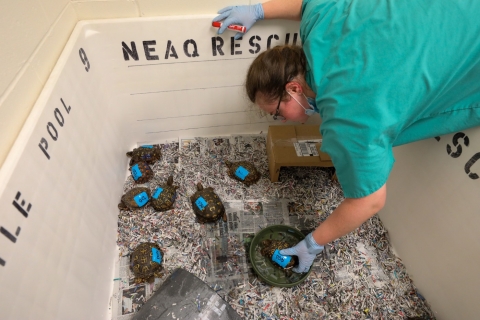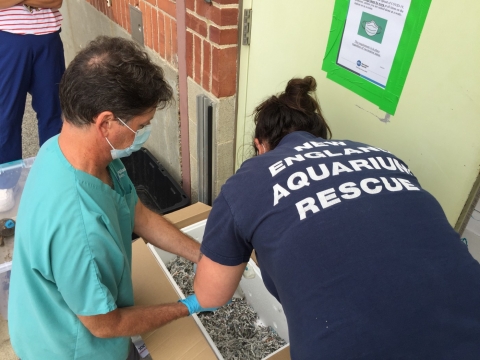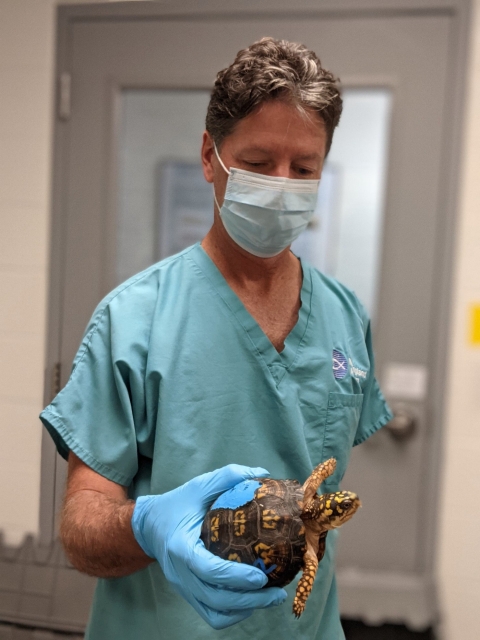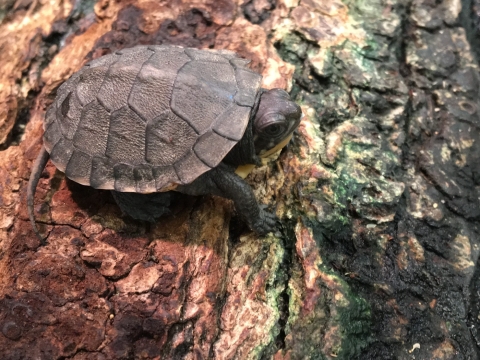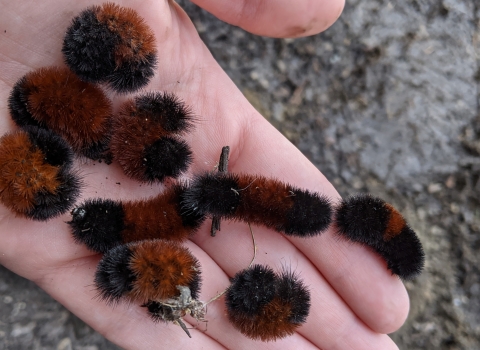What do you get when someone puts multiple turtles taken illegally from the wild together in one box without food or water for several days?
It’s not a joke. It’s a disturbing question wildlife veterinarians were faced with when nearly 100 eastern box turtles, seized from an illegal shipment, were transferred to the New England Aquarium, Zoo New England, and the Roger Williams Park Zoo for care this summer.
The answer, in this case, was a deadly outbreak of ranavirus — a gruesome disease that affects reptiles, amphibians, and fish, and illustrates both the risks and cruelty of the illegal wildlife trade.
“The trafficking of U.S. native turtles is a serious threat to wild populations, and an affront to animal welfare,” said Edward Grace, Assistant Director for the U.S. Fish and Wildlife Service Office of Law Enforcement.
“Smugglers often ship turtles in inhumane conditions that promote the spread of diseases, like ranavirus. We are thankful to our wildlife inspectors for intercepting these turtles before they left the country, and to the many partners who stepped up to provide professional care for them.”
The turtles were already in poor condition when they were discovered hidden inside falsely labeled boxes outbound from a U.S. port to Asia. Each turtle had been stuffed inside a tight sock to prevent it from moving, muffling the telltale sound of claws on cardboard that would signal something inside was alive.
Many had ear and eye infections, likely caused by days of confinement without food, water, or sunlight. They were all severely dehydrated, intentionally.
“When smugglers ship turtles, they often withhold food and water in advance because they don’t want them defecating,” explained Laura DiPrizio, a supervisory wildlife inspector for the Service in the Northeast region. “The smell draws attention.”
After conducting triage — assessing the turtles for injuries, separating sick from healthy, and putting them in large tubs of water to begin to rehydrate — the wildlife inspectors called for backup through the Association of Zoos and Aquariums Saving Animals From Extinction (SAFE) American Turtle Program, which fosters communication between facilities and agencies to ensure confiscated turtles are housed and cared for.
The program arranged for the transfer of the turtles to veterinary facilities at the New England Aquarium, Roger Williams Park Zoo, and Zoo New England, where they were quarantined away from other animals.
Outbreak
In the following weeks, many of the confiscated turtles began to show symptoms of ranavirus, which causes animals to hemorrhage, gasp for air, and accumulate fluid throughout the body. About half of the confiscated turtles died as a result. Transmission occurs through direct contact or through water, and it only takes one infected turtle to cause an outbreak. There is no known treatment.
The Service provided funding for the University of Illinois Wildlife Epidemiology Laboratory to conduct disease screening on tissue samples from a subset of the turtles. The tests confirmed the presence of ranavirus in 93 percent of the samples and detected many co-infections with other pathogens.
With support from the Service and AZA, the remaining turtles have been transferred to the Wildlife Epidemiology Laboratory for care in their bio-secure facility, where veterinarians will investigate disease characteristics for potential long-term options to reduce the impact of the disease.
“The AZA SAFE American Turtle Program worked the way it was supposed to by finding emergency housing for turtles, and providing critical veterinary care that informed our decision to conduct comprehensive disease screening to identify risks of release,” said Dave Collins, who runs the program.
Turtles cannot simply be released after they are confiscated in part because of the potential to introduce diseases to wild populations — not just of turtles, but of frogs, fish, and other wildlife.
“This ranavirus outbreak illustrates the complexity of the challenge, and the ongoing need for resources and research to respond to the native turtle-trafficking crisis,” he said. “It’s a problem too big for one organization to solve.”
The trafficking of U.S. native turtles is an ongoing issue. Previous confiscations and seizures resulting from search warrants have recovered hundreds, or sometimes thousands, of turtles at a time, including species that are listed as federally or state endangered.
“Wildlife trafficking is a massive problem that presents a huge conservation risk for many species, especially turtles,” said Dr. Charles Innis, Director of Animal Health at the New England Aquarium, and a veterinary advisor for the AZA SAFE program.
“When wild animals are amassed in groups by poachers, the likelihood of disease transmission is very high, and then the animals may transmit the disease as they are transported around the world. While this situation is incredibly sad and infuriating, we are inspired by the extensive collaboration that is emerging to confront this problem.”
That includes the Collaborative to Combat the Illegal Trade in Turtles, an offshoot of the Partners in Amphibian and Reptile Conservation, which has supported the coordination needed to develop and disseminate disease-screening and quarantine protocols in anticipation of future confiscations.
“This was a big shipment, but it’s not unusual to see many turtles at a time,” said DiPrizio, “It just represents one day.”
Collaborators are also working to address scientific barriers to repatriating confiscated turtles to the wild. In addition to disease screening, it will require developing genetic databases to narrow down where exactly turtles originated.
But it will take time to develop those tools. In the meantime, the best way to keep native turtles in the wild is to leave them there in the first place.
“Sadly, these confiscated turtles are a stark reminder of the realities of the illegal trade in wildlife,” said Dr. Chris Bonar, Zoo New England Senior Veterinarian. “We hope that through their story we can better educate the public to reduce the demand and prevent future incidents like this.”
Unsustainable demand
Turtles have long been targets of the wildlife trade, whether for food, medicine, or increasingly as status symbols, valued by wealthy collectors for their novelty and beauty. But the internet has fueled unsustainable demand in an unsustainable industry, despite regulations that have been put in place to protect these animals.
It is illegal to collect or possess wild eastern box turtles, as well as many other native turtle species, without a permit (if at all) in most states where it naturally occurs.
It’s also illegal to conceal wildlife in a box and attempt to ship it abroad with false information on the label — a violation of the Lacey Act, and federal regulations for humane wildlife transportation.
The eastern box turtle is protected under the Convention on International Trade in Endangered Species of Wild Fauna and Flora (CITES), an international treaty that restricts trade in species to prevent exploitation. The species cannot be exported without a permit.
Turtles are more vulnerable to illegal collection than most other wildlife because of their life histories. It takes many species a decade or more to reach reproductive age.
But most turtles don’t survive that long — they fall victim to natural predators, like birds and fish, when they are tiny, bite-sized hatchlings. Those that do make it must reproduce for their entire lives, which can range from 30 to over 100 years, to ensure just one hatchling also survives to adulthood to replace them in the population.
When someone takes an individual turtle out of the wild, especially an adult, they could also be taking that turtle’s future replacement. When someone takes dozens of adult turtles, they put entire populations at risk, undermining investments by natural resources agencies and organizations to conserve imperiled species.
Everyone can play a role in stopping the illegal trade in turtles. Help turtles by reporting suspicious behavior, minimizing disturbances to wild turtles, and being a conscientious consumer.
Report suspicious behavior. If you suspect someone is illegally collecting or selling wild turtles, contact the U.S. Fish and Wildlife Service by phone (1–844-FWS-TIPS) or email (fws_tips@fws.gov), or contact your state wildlife agency. The Service is authorized to pay rewards for information or assistance that leads to an arrest, a criminal conviction, civil penalty assessment, or forfeiture of seized property. Payment of rewards is the discretion of the Service and is linked to specific federal wildlife laws. The amount of any reward we may pay is commensurate with the information or assistance received. Please discuss the possibility of receiving a reward with the Service personnel receiving your information or assistance. Do not confront suspicious persons or try to stop a crime yourself. Prioritize your safety.
Don’t share locations of wild turtles, especially online. It can be exciting to see turtles in the wild, and to share your discovery. But if you post a photo of a turtle on social media, don’t include information on where you found it. Turtle poachers mine the internet for this information and use it to target sites. If you want help identifying a turtle you saw in the wild, reach out to a local nature center or your state wildlife agency.
Before you buy, do your homework. Consider choosing a different type of animal to keep as a pet. Pet turtles require specialized care for decades, so be sure you are ready for the commitment. If you are, consider adopting. Check local shelters for unwanted turtles. If you buy, be a cautious consumer. Ask for certification that the turtle was captive bred.


